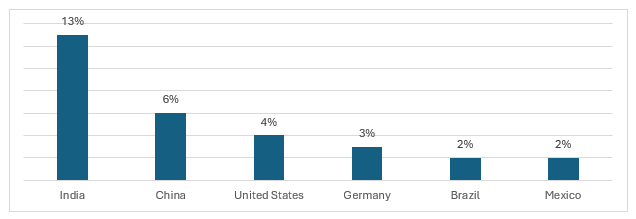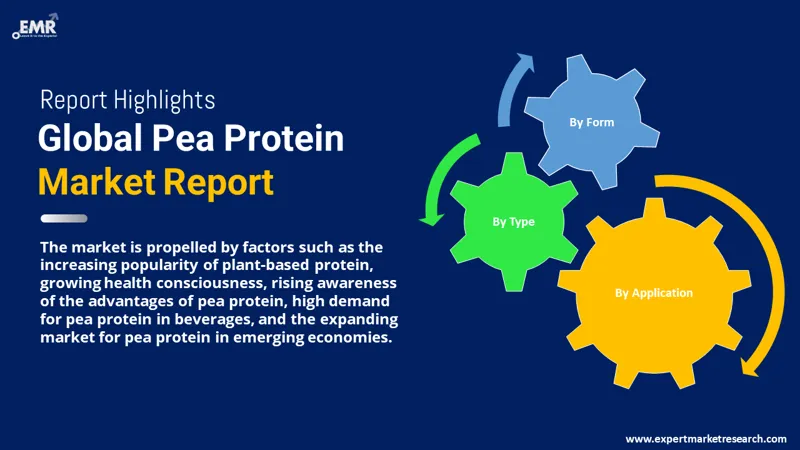
Consumer Insights
Uncover trends and behaviors shaping consumer choices today
Procurement Insights
Optimize your sourcing strategy with key market data
Industry Stats
Stay ahead with the latest trends and market analysis.
The global pea protein market size reached around USD 2903.37 Million in 2025. The market is estimated to witness robust growth in the coming years, growing at a CAGR of 20.10% in the forecast period of 2026-2035, reaching a value of USD 18127.27 Million by 2035.
Base Year
Historical Period
Forecast Period
Reportedly, there are about 88 million vegans on a global scale.
The clean label trend is stimulating processed food manufacturers to include pea protein as a food ingredient.
The consumption of pea protein is supported by its hypoallergenic nature.
Compound Annual Growth Rate
20.1%
Value in USD Million
2026-2035
*this image is indicative*
Food ingredients, such as pea proteins, that provide health benefits gained popularity among functional food manufacturers to meet the consumers' demand for functional foods and drinks. Pea proteins are rich in antioxidants that protect the body from damage caused by free radicals and boost the immune system functioning.
Figure: Share of Vegans in Selected Countries in 2022

The potential health benefits of pea protein, such as hypoallergenic properties, high iron content, and improved metabolism, among others, are driving its use in diverse applications. Besides, due to lesser health controversy in comparison to other plant-based proteins like soy protein, the preference for pea protein among end users has surged significantly.
Trend towards vegan diet and vegetarianism has increased the demand for pea protein as it can also be consumed by individuals who are lactose intolerant or those who do not include dairy-based protein.
The rising vegan population; increasing awareness of the health benefits of pea protein; environmental benefits offered by pea protein production; and expansion of the e-commerce sector are the major factors impacting the pea protein market growth
With the rising flexitarian and vegan population, the use of pea protein in various food and beverage applications like sports supplements and as an alternative protein over traditional sources like meat, among others, has been increasing significantly.
Various health benefits, such as digestibility and anti-allergen properties, are driving the demand for pea protein over other plant-based proteins. Moreover, the increasing focus on weight management and the rising demand for healthy food ingredients are favouring the pea protein market development.
The production of pea protein offers several environmental benefits, including low CO2 absorption, low energy consumption, and reduced water consumption, which is boosting its preference among the environmentally conscious population.
An expanding e-commerce sector has increased the availability of organic pea protein products, helping fitness enthusiasts meet their post-workout recovery as well as fitness needs.
In the expanding food processing sector, pea protein flours, concentrates, and isolates are used in the production of normal- and low-fat sausages. Pea protein can also be used as an additive for emulsions, owing to its water and fat binding, emulsifying, and foam stabilisation properties. It can function as a substitute for eggs in vegan cookies and cakes and allows bakers to increase the protein content in bread.
Manufacturers are boosting their raw material sourcing capabilities by focusing on sustainability, improving raw material quality and traceability along with strengthening their relationship with raw material suppliers. By adopting logistics intelligence, they can further enhance raw material quality and optimise operations.

Read more about this report - REQUEST FREE SAMPLE COPY IN PDF
“Global Pea Protein Market Report and Forecast 2026-2035” offers a detailed analysis of the market based on the following segments:
Market Breakup by Type
Market Breakup by Form
Market Breakup by Application
Market Breakup by Region
Based on type, isolates account for a significant pea protein market share
Pea protein isolate based products are an excellent choice for people aiming to lose weight and build muscle as they contain high amount of protein and amino acids. In December 2020, Ingredion introduced its first pea protein isolate, which contains at least 80% protein, for use in a variety of products such as nutrition and sports bar, powdered and ready-to-drink beverages, and more. The naturally gluten-free pea protein isolate supports manufacturers of different products to make claims like ‘vegetarian’, ‘vegan’ and ‘high-in-protein’.
Textured pea protein is a sustainable alternative to meat. As more and more people join the trend of switching to plant-based diet, the demand for textured pea protein is expected to increase in the coming years.
Bakery and confectionery represents the leading application segment in the global pea protein market
Pea protein, a plant-based ingredient available as isolates, concentrates and flour, is widely used by bakers to increase the protein content of breads and other baked goods. The addition of pea protein benefits in water holding, as well as gelation and browning applications, particularly in gluten-free formulations.
The rising awareness among consumers is encouraging them to purchase bread and baked goods that include well-recognised, organic and non-GMO proteins, such as pea protein. The clean label trend is compelling food manufacturers to include pea protein as a food ingredient.
The market players are expanding their capacities, setting up new production plants, diversifying supply chain, and developing products with widespread applications and enhanced stability.
Yantai Shuangta Food Co., Ltd, is a publicly listed company headquartered in China. The company offers pea protein, mung bean protein, potato vermicelli, crystal vermicelli, mung bean sheet jelly, etc.
Founded in 2003, Jianyuan Group is a renowned manufacturer of pulse ingredients worldwide. The company utilises advanced technology and services to produce high-quality field pulse ingredients.
Headquartered in France, the company offers products for various sectors including biopharma, cosmetics, food and nutrition, animal nutrition, and others.
Founded in 1852, Cosucra is engaged in manufacturing products based on chicory roots and yellow peas. The company has a global presence with three processing plants and more than 300 employees worldwide.
*Please note that this is only a partial list; the complete list of key players is available in the full report. Additionally, the list of key players can be customized to better suit your needs.*
Other notable players operating in the global pea protein market are Burcon NutraScience Corporation, Axiom Foods, Inc., and Naturz Organics, among others.
In North America, pea protein is perceived as a healthy option by consumers across countries like the United States and Canada, due to its familiarity and plant-based and label-friendly nature. This enhances its applications and subsequent demand in diverse applications.
The rising flexitarian population in Asia Pacific countries like Japan, India, and Singapore is likely to surge the demand for pea protein that can mimic the mouthfeel and taste of meat. The wide availability of locally produced pea protein-based products in physical retail stores and e-commerce platforms has aided pea protein market in APAC.
Italy Protein Market
France Protein Market
Europe Protein Market
Germany Protein Market
Canada Protein Market
Europe Whey Protein Concentrate Market
Protein Market
United States Plant Protein Market
United States Rice Protein Market
United States Hemp Protein Market




*While we strive to always give you current and accurate information, the numbers depicted on the website are indicative and may differ from the actual numbers in the main report. At Expert Market Research, we aim to bring you the latest insights and trends in the market. Using our analyses and forecasts, stakeholders can understand the market dynamics, navigate challenges, and capitalize on opportunities to make data-driven strategic decisions.*
Get in touch with us for a customized solution tailored to your unique requirements and save upto 35%!
The market reached a value of around USD 2903.37 Million in 2025.
The market is projected to grow at a CAGR of 20.10% between 2026 and 2035.
The market is estimated to witness a healthy growth in the forecast period of 2026-2035 to reach a value of USD 18127.27 Million by 2035.
The different types are isolate, concentrate, and textured pea protein.
The key regional markets for pea protein are North America, Europe, the Asia Pacific, Latin America, and the Middle East and Africa.
Pea protein finds application in bakery and confectionery, functional food and beverages, meat additives, and sports nutrition.
The factors driving the market include the increasing inclination towards veganism and clean label foods, the growing food and beverage sector, and increased demand for gluten-free bakery products.
The key players in the market include Yantai Shuangta Food Co., Ltd, Shandong Jianyuan Group, Roquette Frères S.A., COSUCRA Groupe Warcoing S.A., Burcon NutraScience Corporation, Axiom Foods, Inc., and Naturz Organics, among others.
Explore our key highlights of the report and gain a concise overview of key findings, trends, and actionable insights that will empower your strategic decisions.
| REPORT FEATURES | DETAILS |
| Base Year | 2025 |
| Historical Period | 2019-2025 |
| Forecast Period | 2026-2035 |
| Scope of the Report |
Historical and Forecast Trends, Industry Drivers and Constraints, Historical and Forecast Market Analysis by Segment:
|
| Breakup by Type |
|
| Breakup by Form |
|
| Breakup by Application |
|
| Breakup by Region |
|
| Market Dynamics |
|
| Competitive Landscape |
|
| Companies Covered |
|
| Report Price and Purchase Option | Explore our purchase options that are best suited to your resources and industry needs. |
| Delivery Format | Delivered as an attached PDF and Excel through email, with an option of receiving an editable PPT, according to the purchase option. |
Datasheet
One User
USD 2,499
USD 2,249
tax inclusive*
Single User License
One User
USD 3,999
USD 3,599
tax inclusive*
Five User License
Five User
USD 4,999
USD 4,249
tax inclusive*
Corporate License
Unlimited Users
USD 5,999
USD 5,099
tax inclusive*
*Please note that the prices mentioned below are starting prices for each bundle type. Kindly contact our team for further details.*
Flash Bundle
Small Business Bundle
Growth Bundle
Enterprise Bundle
*Please note that the prices mentioned below are starting prices for each bundle type. Kindly contact our team for further details.*
Flash Bundle
Number of Reports: 3
20%
tax inclusive*
Small Business Bundle
Number of Reports: 5
25%
tax inclusive*
Growth Bundle
Number of Reports: 8
30%
tax inclusive*
Enterprise Bundle
Number of Reports: 10
35%
tax inclusive*
How To Order

Select License Type
Choose the right license for your needs and access rights.

Click on ‘Buy Now’
Add the report to your cart with one click and proceed to register.

Select Mode of Payment
Choose a payment option for a secure checkout. You will be redirected accordingly.
Gain insights to stay ahead and seize opportunities.

Get insights & trends for a competitive edge.

Track prices with detailed trend reports.

Analyse trade data for supply chain insights.

Leverage cost reports for smart savings

Enhance supply chain with partnerships.

Connect For More Information
Our expert team of analysts will offer full support and resolve any queries regarding the report, before and after the purchase.
Our expert team of analysts will offer full support and resolve any queries regarding the report, before and after the purchase.
We employ meticulous research methods, blending advanced analytics and expert insights to deliver accurate, actionable industry intelligence, staying ahead of competitors.
Our skilled analysts offer unparalleled competitive advantage with detailed insights on current and emerging markets, ensuring your strategic edge.
We offer an in-depth yet simplified presentation of industry insights and analysis to meet your specific requirements effectively.
Share